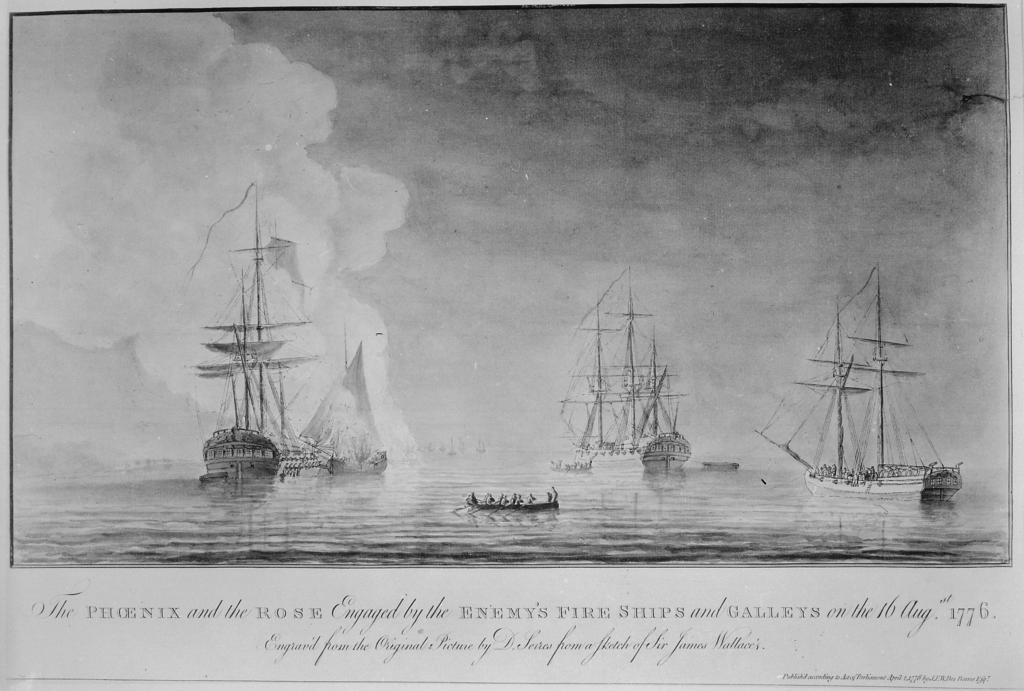CANNONS FOUND IN SAVANNAH RIVER: Three cannons were recently recovered from the Savannah River, and speculation is they may have come from the wreck of the HMS Rose, which was purposefully sunk by the British in 1779. But, according to Dr. E. Lee Spence’s research the Rose’s guns were removed prior to her being scuttled. So what is their source?
Here is the entry for the wreck of HMS Rose from Dr. E. Lee Spence’s book Shipwrecks of South Carolina & Georgia 1520-1865 (published by the Sea Research Society, Charleston, SC, 1985).
1779-9-US-SC/GA-8: His British Majesty’s frigate Rose, Captain John Brown, was scuttled by the British on Garden Bank, a shoal in the Savannah River, near Hutchinson Island on September 20, 1779, in an effort to keep the combined American and French fleet from passing up the channel to Savannah, Georgia. The orders to scuttle the Rose were given by a Captain Henry who had as many of her stores “as time would admit” taken out of her prior to her sinking. The Rose’s guns were removed prior to her being scuttled and were mounted in the fortifications by the British for the defense of Savannah.
Note One: “The Gazette of the State of South Carolina” of August 11, 1779, gave the location of her sinking as at Cockspur, Georgia.
Note Two: Robert Marx’s book Shipwrecks of the Western Hemisphere incorrectly lists her as sunk “to block the bar at the entrance of Savannah.”
Note Three: HMS Rose was a “6th Rate” frigate of twenty (or twenty-four) guns. The Rose was launched by Blaydes at Hull on March 8, 1757. The Rose was 449 tons builder’s measurement; 110′ in length; and 30′ in beam.
Note Four: The Rose was said to have been in bad condition, which may have been one of the reasons why she was picked to be sunk as an obstruction. The wreck’s location on Garden Bank shoal is amply supported by contemporary journals and subsequent charts detailing the British defense of Savannah.
Note Five: See also entry 1779-9-US-SC/GA-7 of this list.
References for 1779-9-US-SC/GA-8:
“Gazette of the State of South Carolina,” (Charleston, SC), #2141, August 11, 1779, p. 2, c. 2
History of the Revolution in South Carolina, by David Ramsay, (Trenton, 1785), Volume 2, p. 35
British Warship Names, by T.D. Manning and C.F. Walker, (1959), London, p. 379
Royal Navy: A History From the Earliest Times to the Present, by William Laird Clowes, (1898, republished 1966), Volume 4, p. 110
Ships of the Royal Navy: an Historical Index, by J.J. Colledge, (New York, 1969), Volume 1, p. 471
Chatham County Map Portfolio, chart #4 (original by John McKinnon is in City Engineer’s Office at Savannah, GA); chart #5 (original by John McKinnon was published in Savannah River Rice Plantations, by W. Lathrop Hopkins)
Shipwrecks of the Western Hemisphere: 1492-1825, by Robert F. Marx, (World Publishing Company, New York, 1971), p. 184, #343
Charleston’s Maritime Heritage 1670-1865, by P.C. Coker III, (CokerCraft Press, Charleston, SC, 1987), p. 102
1779-9-US-SC/GA-7: HMS Rose, the English ship Savannah, the transport Venus and three or four unidentified British transports “richly freighted” with flour, rice, ammunition and other “necessities,” were burned and sunk by the British in the narrowest part of the channel of the Savannah River below the city during the French and American siege of Savannah in September of 1779, to block the passage of the French and American fleet. Artifacts attributed to these wrecks were recovered from the Savannah River in 1873 and again in 1885.
Note: For additional information on individual vessels mentioned above, see also entries 1779-9-US-SC/GA-8 through 1779-9-US-SC/GA-11 of this list.
References for 1779-9-US-SC/GA-7:
History of the Revolution in South Carolina, by David Ramsay, (Trenton, 1785), Volume 2, p. 35
Royal Navy: A History From the Earliest Times to the Present, by William Laird Clowes, (1898, republished 1966), Volume 4, p. 110
The Siege of Savannah by the Fleet of Count D’Estaing in 1779, edited by Charles C. Jones, Jr., (Arno Press, 1968), pp. 51, 52, 61
A History of Georgia from its First Discovery by Europeans to the adoption of the Present Constitution in 1798, by William Bacon Stevens, (1972), The Beehive Press, Savannah, Georgia, Volume 2, p. 205
History of Georgia, by C.C. Jones, Volume 2, pp. 385. 413
Muskets, Cannon Balls and Bombs, by Benjamin Kennedy, pp. 30, 82, 83
“Ships Named Savannah,” by Amy Chambliss, typed manuscript in the collection of the Georgia Historical Society, Savannah, Georgia, p. 15
Untitled typewritten catalog of artifacts in the collection of the Georgia Historical Society, entries 74-1-1 through 74-1-10
Georgia Historical Quarterly, Volume 18, pp. 147, 148
Chatham County Map Portfolio, chart #4 (original by John McKinnon is in City Engineer’s Office at Savannah, GA); chart #5 (original by John McKinnon was published in Savannah River Rice Plantations, by W. Lathrop Hopkins)
“Georgia Historical Society Minute Book 2” (bound manuscript) entry for April 6, 1874
Georgia Historical Markers, by C.P. Scruggs, p. 98
This is a link to the News Story mentioned above: https://currently.att.yahoo.com/att/crews-were-dredging-river-instead-090151949.html?fbclid=IwAR1yVkNSE1WDIdFDYIzBBNvhN8IA9kwH6R0fP2NGPIp2pB4-CeHAltTg-6A&guccounter=1&guce_referrer=aHR0cHM6Ly9sLmZhY2Vib29rLmNvbS8&guce_referrer_sig=AQAAAKjymrj-KtZ9JhJNqKIkroX3760JkwL7pau1KQYIUSGopRuUfCUOs_6vFrj5VOIWJ84BMwDcltH4Zc4N3mCCx7UBOs2nS3L8Gg8XBPh3PUNGUoZWdXA5IlngdokXRxeHAzl5UQfIfXUGETam9uz8ia1K6fgF3CefHZotQiVUH2dV
